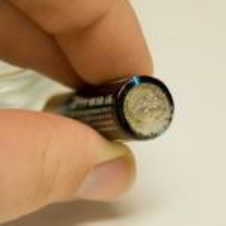
Cleaning Battery Corrosion From Camera
Equipment
By Bryce Bertola
A corroded AA battery found inside a nikon SB-25 flash
I recently acquired a Nikon SB-25 flash that wasn’t working. According to the previous
owner, it has sat on a shelf for over a years and it hadn’t worked when they tried to use it a
few weeks ago. I opened up the battery cover to see if it just needed fresh batteries and I was
greeted with 4 badly corroded batteries. After removing the batteries and exchanging them
with fresh ones, the flash was still not powering up. The corrosion had spread to the metal
contact points and made the flash unusable. Fortunately, corrosion caused by battery acid can
be dissolved using vinegar, and that would most likely fix the problem.
What You Need
To clean battery corrosion, you will need vinegar and Q-tips
In order to clean the corrosion off your sensitive equipment you will need the following:
Vinegar – You can use any regular household variety
Q-Tips – Used to apply the vinegar to terminals and hard-to-reach spots
Gloves – Battery acid can cause skin irritation (As I learned later) and so you should
always wear gloves when dealing with it
How to Clean Battery Corrosion From Your Equipment

Start by setting up your work area. I placed a couple of paper towels on my counter in order
to catch any of the mess. Pour a small amount of vinegar, about 1/4 cup, into a container to
soak the Q-tips in.
The Vinegar will start to fizz when it comes in contact with corroded material.
When the vinegar comes in contact with the corroded material, it causes it to dissolve, and it
will appear to fizz or bubble. Using the Q-tips, apply the vinegar to the areas where corrosion
has occurred, leaving time for the vinegar to dissolve the build-up. After a few moments you
should wipe the area clean with the dry end of the Q-tip, and repeat the process again a
couple of times.
After a few rounds of applying and cleaning off the vinegar you should see a noticeable
difference. At this point you should be able to insert a set of fresh batteries and test them out.
If it doesn’t appear to work, try a few more rounds of applying and cleaning.
And The End Result Is….
After cleaning off the battery contact points I was able to insert a fresh set of batteries and the
flash powered up immediately! I’ll keep testing it out over the next few weeks to make sure
everything still works, but thanks to a little bit of work, I was able to save a flash!
